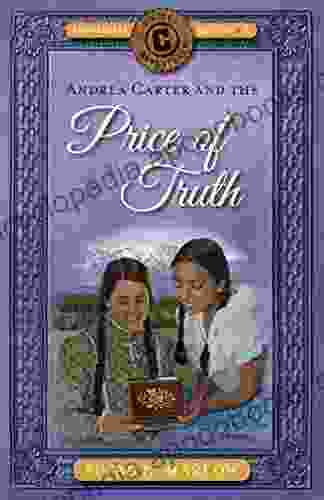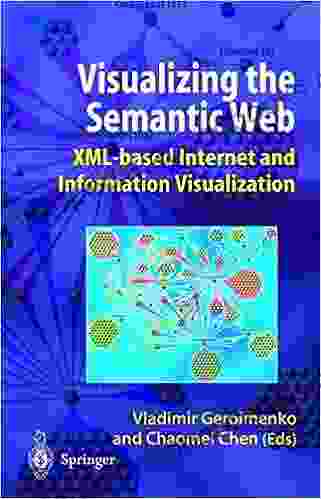XML-Based Internet and Information Visualization: The Ultimate Guide

5 out of 5
| Language | : | English |
| File size | : | 4742 KB |
| Text-to-Speech | : | Enabled |
| Screen Reader | : | Supported |
| Print length | : | 212 pages |
Table of Contents
- XML-Based Visualization Techniques
- Best Practices for XML-Based Visualization
- Interactive Data Visualization with XML
- Case Studies
In today's data-driven world, the ability to visualize and communicate data effectively is more important than ever. XML-based visualization is a powerful technique that allows you to create interactive and compelling data visualizations that can help you uncover insights, make better decisions, and engage your audience.
This book provides a comprehensive guide to XML-based visualization, covering everything from the basics of XML to advanced techniques for creating interactive data visualizations. Whether you're a beginner or an experienced developer, this book will help you take your data visualization skills to the next level.
XML-Based Visualization Techniques
XML is a powerful language for representing data in a structured way. This makes it an ideal format for data visualization, as it allows you to easily create visualizations that are both accurate and visually appealing.
There are a number of different XML-based visualization techniques that you can use, including:
- Treemaps: Treemaps are a type of visualization that displays data in a nested hierarchy. They are useful for showing the relative sizes of different parts of a whole.
- Sunbursts: Sunbursts are a type of visualization that is similar to treemaps, but they are displayed in a circular format. This makes them ideal for showing how different parts of a whole are related to each other.
- Heatmaps: Heatmaps are a type of visualization that displays data in a grid format. They are useful for showing the distribution of data across a particular area.
- Scatterplots: Scatterplots are a type of visualization that displays data as a series of points on a graph. They are useful for showing the relationship between two variables.
- Line charts: Line charts are a type of visualization that displays data as a series of lines on a graph. They are useful for showing trends over time.
The choice of which XML-based visualization technique to use will depend on the type of data you have and the insights you want to uncover.
Best Practices for XML-Based Visualization
When creating XML-based visualizations, there are a number of best practices that you should follow to ensure that your visualizations are effective and easy to understand.
Some of the best practices for XML-based visualization include:
- Use a clear and concise data structure. The structure of your XML data will determine how your visualization is displayed. Make sure that your data is organized in a way that makes sense and is easy to understand.
- Choose the right visualization technique. There are a number of different XML-based visualization techniques available. Choose the technique that is most appropriate for the type of data you have and the insights you want to uncover.
- Use color and typography effectively. Color and typography can be used to enhance the visual appeal of your visualizations and make them easier to understand. Use colors that are visually appealing and complementary, and choose fonts that are easy to read.
- Test your visualizations. Once you have created your visualizations, test them with users to make sure that they are effective and easy to understand. Get feedback from users and make changes as needed.
By following these best practices, you can create XML-based visualizations that are both effective and engaging.
Interactive Data Visualization with XML
One of the most powerful features of XML-based visualization is the ability to create interactive visualizations. Interactive visualizations allow users to explore data in a more hands-on way, which can lead to deeper insights and understanding.
There are a number of different ways to create interactive data visualizations with XML. Some of the most common techniques include:
- Zooming and panning: Zooming and panning allows users to explore different parts of a visualization in more detail.
- Filtering: Filtering allows users to filter data based on specific criteria.
- Sorting: Sorting allows users to sort data based on specific criteria.
- Tooltips: Tooltips provide users with additional information about specific data points.
By adding interactive features to your visualizations, you can make them more engaging and informative for users.
Case Studies
To illustrate the power of XML-based visualization, let's take a look at a few case studies:
- Case study 1: A large healthcare organization used XML-based visualization to create an interactive dashboard that allowed them to track key performance indicators (KPIs) across their entire organization. The dashboard provided the organization with a real-time view of their performance, which allowed them to identify areas for improvement and make better decisions.
- Case study 2: A financial services company used XML-based visualization to create a customer segmentation tool that helped them to identify and target their most valuable customers. The tool allowed the company to understand the needs of their customers and develop marketing campaigns that were more effective.
- Case study 3: A government agency used XML-based visualization to create an interactive map that allowed users to track the spread of a disease. The map provided the agency with a real-time view of the outbreak, which allowed them to take steps to contain the spread of the disease.
These case studies demonstrate the power of XML-based visualization to solve real-world problems.
XML-based visualization is a powerful technique that allows you to create interactive and compelling data visualizations that can help you uncover insights, make better decisions, and engage your audience.
This book has provided you with a comprehensive guide to XML-based visualization, covering everything from the basics of XML to advanced techniques for creating interactive data visualizations. Whether you're a beginner or an experienced developer, this book has something for you.
So what are you waiting for? Get started with XML-based visualization today and start unlocking the power of your data!
5 out of 5
| Language | : | English |
| File size | : | 4742 KB |
| Text-to-Speech | : | Enabled |
| Screen Reader | : | Supported |
| Print length | : | 212 pages |
Do you want to contribute by writing guest posts on this blog?
Please contact us and send us a resume of previous articles that you have written.
 Book
Book Novel
Novel Page
Page Chapter
Chapter Text
Text Story
Story Genre
Genre Reader
Reader Library
Library Paperback
Paperback E-book
E-book Magazine
Magazine Newspaper
Newspaper Paragraph
Paragraph Sentence
Sentence Bookmark
Bookmark Shelf
Shelf Glossary
Glossary Bibliography
Bibliography Foreword
Foreword Preface
Preface Synopsis
Synopsis Annotation
Annotation Footnote
Footnote Manuscript
Manuscript Scroll
Scroll Codex
Codex Tome
Tome Bestseller
Bestseller Classics
Classics Library card
Library card Narrative
Narrative Biography
Biography Autobiography
Autobiography Memoir
Memoir Reference
Reference Encyclopedia
Encyclopedia Shaila Abdullah
Shaila Abdullah Jake Townsend
Jake Townsend C D Carter
C D Carter Sherry L Deckman
Sherry L Deckman Bagyalakshmi S
Bagyalakshmi S 42nd Edition Kindle Edition
42nd Edition Kindle Edition Jolin White
Jolin White Britney Banski
Britney Banski Tracie Barton Barrett
Tracie Barton Barrett Leddy Harper
Leddy Harper Mark Blyth
Mark Blyth A J Baime
A J Baime Penelope Monit
Penelope Monit Jenny Mccartney
Jenny Mccartney A J Scudiere
A J Scudiere Jude Deveraux
Jude Deveraux Felipe Alvarez
Felipe Alvarez Clifton Craig
Clifton Craig J L Fizzell
J L Fizzell Gail Schimmel
Gail Schimmel
Light bulbAdvertise smarter! Our strategic ad space ensures maximum exposure. Reserve your spot today!

 Richard WrightUnlocking the Secrets of Aquatic Ecosystems: Social Ecological Analysis of...
Richard WrightUnlocking the Secrets of Aquatic Ecosystems: Social Ecological Analysis of...
 Marcel ProustExploring Fantasy and Desire in Analytical Psychology: A Comprehensive Guide...
Marcel ProustExploring Fantasy and Desire in Analytical Psychology: A Comprehensive Guide...
 Christopher WoodsStudies in the Organization for Security and Co-operation in Europe (OSCE):...
Christopher WoodsStudies in the Organization for Security and Co-operation in Europe (OSCE):... Robin PowellFollow ·15.2k
Robin PowellFollow ·15.2k Arthur Conan DoyleFollow ·11.1k
Arthur Conan DoyleFollow ·11.1k Julio CortázarFollow ·2.4k
Julio CortázarFollow ·2.4k Milan KunderaFollow ·5.4k
Milan KunderaFollow ·5.4k Jerome PowellFollow ·6.1k
Jerome PowellFollow ·6.1k Stan WardFollow ·6k
Stan WardFollow ·6k James HayesFollow ·4k
James HayesFollow ·4k Liam WardFollow ·15.9k
Liam WardFollow ·15.9k

 Jacob Hayes
Jacob HayesUnlock the Power of Microsoft Word: A Comprehensive Guide...
Microsoft Word is a widely used word...

 Hunter Mitchell
Hunter MitchellAndrea Carter and the Price of Truth: A Thrilling...
Get ready for an unforgettable...

 Ivan Turner
Ivan TurnerTrading Jeff and His Dog: An Unforgettable Adventure of...
Get ready for an emotional rollercoaster...

 Langston Hughes
Langston HughesGo Viral TikTok: The Ultimate Guide to Gaining 100K...
TikTok has emerged as a social...

 Ibrahim Blair
Ibrahim BlairUnveil the Enchanting Realm of Short Fiction: Dive into...
Delve into a Literary Tapestry of...

 Tennessee Williams
Tennessee WilliamsUnveil the Enchanting World of Elizabeth Barrett...
A Poetic Tapestry of Love, Loss, and...
5 out of 5
| Language | : | English |
| File size | : | 4742 KB |
| Text-to-Speech | : | Enabled |
| Screen Reader | : | Supported |
| Print length | : | 212 pages |






